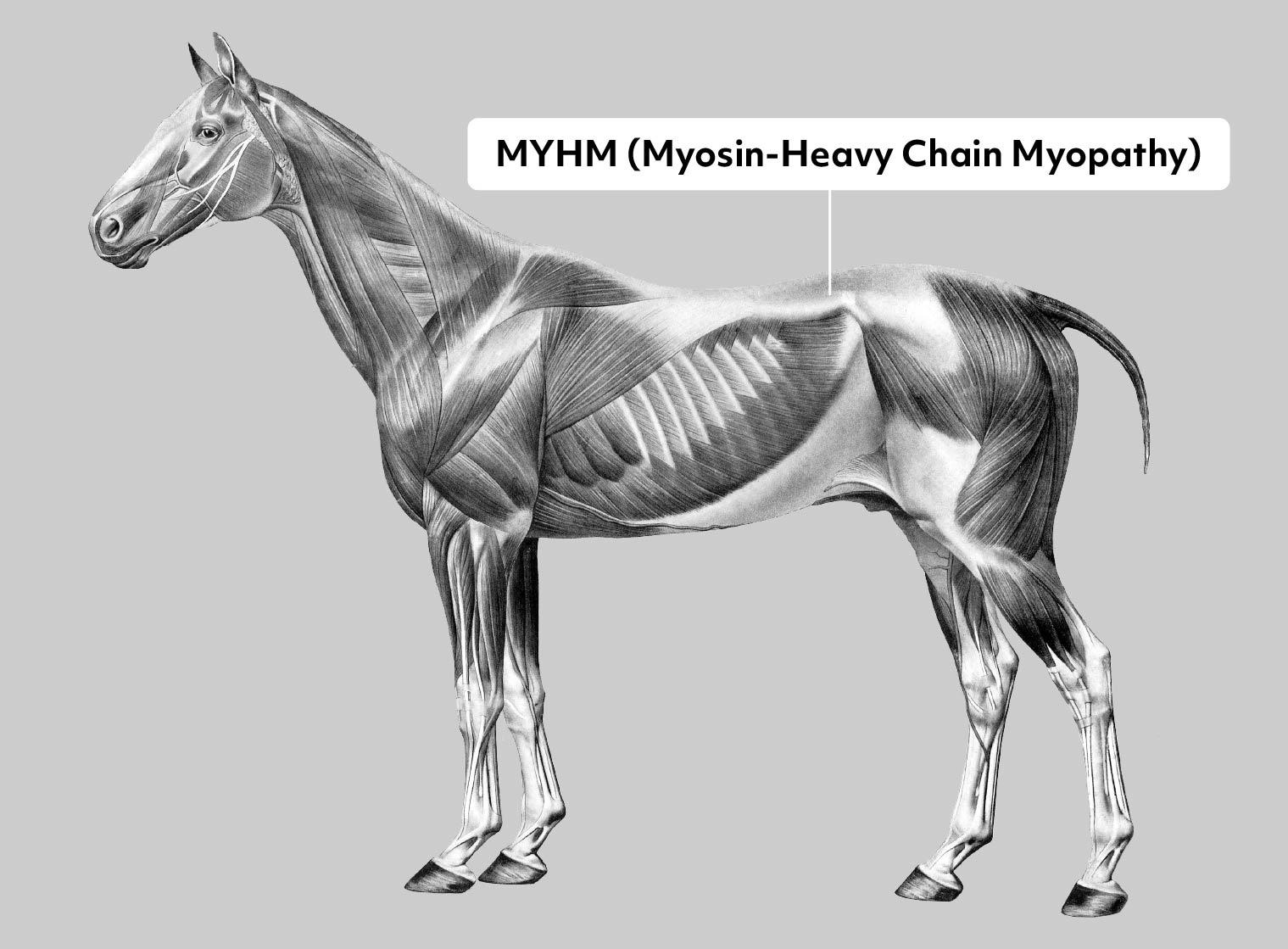Myosin-Heavy Chain Myopathy (MY & IMM)
Gene or Region: MYH1
Reference Variant: G
Mutant Variant: A
Affected Breeds: Quarter Horse
Research Confidence: Moderate - Strong association in initial studied population, requires expanded research and review
Explanation of Results: MYHM/MYHM = homozygous for Myosin Heavy Chain Myopathy, increased risk of muscle damage/atrophy following autoimmune event (previously named "IMM") MYHM/n = heterozygous for Myosin Heavy Chain Myopathy, moderate risk of muscle damage/atrophy following autoimmune event n/n = no variant detected
General Description for Myosin-Heavy Chain Myopathy (MYHM)
Myosin-Heavy Chain Myopathy (MYHM; previously "IMM") is a genetic muscle disease found most commonly in stock-type horses that can result in two different presentations, Immune-Mediated Myositis (IMM) and Nonexertional Rhabdomyolysis “tying up,” which are both characterized by muscle damage or loss. Both presentations are associated with the same genetic variant. Horses with an MY variant may exhibit one or both presentations at different times in their lives, although some horses carrying the variant might not display any symptoms at all.
One presentation of MYHM is Immune-Mediated Myositis (IMM), which is an autoimmune disease that, when triggered by environmental factors such as an infection or certain vaccinations (i.e. influenza) can cause severe muscle loss (atrophy) within 3 days (up to 40% in 72 hours). Target areas of atrophy include the gluteal and vertebral regions (hind end and top line) as the characteristic inflammation attacks the muscle fibers and surrounding blood vessels. Symptoms include general malaise, muscle stiffness, and overall weakness, not associated with exercise, and usually affect horses older than 17 or younger than 8 years of age.
The second presentation, Nonexertional Rhabdomyolysis or “tying up,” manifests as stiffness accompanied by potential muscle swelling in similar target areas as IMM along the back and haunches in the absence of exercise. Nonexertional Rhabdomyolysis causes muscle pain and cramping that may or may not result in muscle atrophy. Horses that experience either presentation can recover but may face more frequent episodes in the future.
MYH1 or Myosin Heavy Chain 1 is a gene thought to have an altered amino acid that disrupts the function of the myosin cells in muscle tissue. The initial study that evaluated the link between MYH1 mutation and IMM (cited below) indicates autosomal dominance, meaning heterozygous horses (MYHM/n) may be at risk in addition to homozygous horses (MYHM/MYHM), although it is believed that homozygous horses will likely experience more severe symptoms. As MYHM is thought to have variable penetrance, not all horses who carry copies of MYHM will exhibit symptoms nor is there a particular increased effect for males versus females (both sexes appear to be equally affected).
Environmental factors and infection exposure (such as Equine Herpes Type 4, Streptococcus equi, respiratory virus, etc.) may act as triggers as they were also noted in the health histories of 39% of the horses in the original IMM study. As not all environmental factors contributing to the risk are presently understood, predicting the impact or manifestation of the MYH1 regional mutation on a horse remains challenging. Consequently, having your horse evaluated for MY through genetic testing is crucial, as effective management plays a pivotal role in averting potential episodes.
- Additional studies with larger equine populations will continue to increase validation into the exact function of this genetic region and the corresponding health of horses. As with any medical test, genetic test, or identification of genetic sequences within your horse, we recommend speaking with your veterinarian regarding any questions you may have about your individual horse’s health or care.
References
Finno CJ, Gianino G, Perumbakkam S, Williams ZJ, Bordbari MH, Gardner KL, Burns E, Peng S, Durward-Akhurst SA, Valberg SJ. (2018). A missense mutation in MYH1 is associated with susceptibility to Immune-mediated myositis in Quarter Horses. Skelet Muscle 8(1):7. doi: 10.1186/s13395-018-0155-0.
Durward-Akhurst SA, Valberg SJ. (2018). Immune-Mediated Muscle Diseases of the Horse. Vet Pathol 55(1):68-75.
Lewis SS, Valberg SJ, Nielsen IL. (2007). Suspected immune-mediated myositis in horses. J Vet Intern Med 21:495-503.
More Horse Health
"Warmblood" Fragile Foal Syndrome
"Warmblood" fragile foal syndrome (FFS) is a connective tissue disorder resulting in joint laxity and extremely thin skin that is only loosely connected to the body. The skin is easily torn, resulting in lacerations, hematomas, and seromas across the foal. Affected foals are euthanized shortly after birth.
Androgen Insensitivity Syndrome
Androgen Insensitivity Syndrome (AIS) is an X-linked disorder of sexual development resulting in a female horse with XY chromosomes. Horses with AIS exhibit stallion-like behavior such as agression toward other horses, Flehman response and vocalization toward cycling mares.
Cerebellar Abiotrophy
Cerebellar Abiotrophy (CA) is a degenerative neurological disorder, due to the death of neurons in the brain. Symptoms (head tremors, lack of coordination, wide stances, exaggerated gain, difficulty rising and startling easily), typically appear in foals between six weeks and four months of age.
Chronic Idiopathic Anhidrosis Risk
Chronic Idiopathic Anhidrosis Risk (CIA) is the inability to sweat in response to increased body temperature, (AKA "non-sweater"). This condition is dangerous and sometimes life-threatening for horses, who rely on sweating for 65-70% of their temperature regulation.
